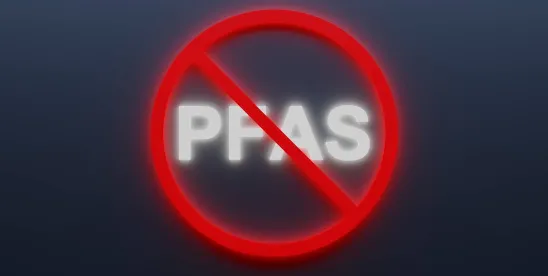On August 15, 2025, Illinois Governor JB Pritzker (D) signed a bill (HB 2516) amending the PFAS Reduction Act to ban certain consumer products containing intentionally added per- and polyfluoroalkyl substances (PFAS). As of January 1, 2032, intentionally added PFAS are banned in cosmetics, dental floss, juvenile products, menstrual products, and intimate apparel. The Act defines PFAS as “a class of fluorinated organic chemicals containing at least one fully fluorinated carbon atom.” The bill defines intentionally added PFAS as “PFAS that are deliberately added during the manufacture of a product if the continued presence of the PFAS is desired in the final product or desired in one of the product’s components to perform a specific function in the final product” and specifically excludes “PFAS that are present in the product due to use of water containing PFAS if the manufacturer took no action that resulted in the PFAS being present in the water.”
Under the enacted bill, by August 1, 2027, the Illinois Environmental Protection Agency (IEPA) must submit a report to the General Assembly that includes:
- An assessment of statutory and regulatory authority, administrative infrastructure, research capabilities, and funding necessary to develop and implement a program for the review of fluoropolymers used in consumer products and their potential threat to human health and the environment;
- An assessment of available scientific data regarding fluoropolymers, as well as an assessment of other state or federal statutory or regulatory actions taken regarding fluoropolymers; and
- An assessment of potential critical uses of fluoropolymers and their relation to the supply chain.
The bill defines fluoropolymers as “fluoropolymers consisting of polymeric substances for which the backbone of the polymer is either a perfluorinated or polyfluorinated carbon-only backbone or a perfluorinated polyether.”
The original bill introduced on February 3, 2025, included no reference to fluoropolymers. It also would have banned intentionally added PFAS in cookware and food packaging. As reported in our April 11, memorandum, on April 8, 2025, New Mexico enacted the Per- and Poly-Fluoroalkyl Substances (PFAS) Protection Act (HB 212). Like Minnesota and Maine, New Mexico will phase out certain consumer products containing intentionally added PFAS before later prohibiting products containing intentionally added PFAS unless the use is designated as a currently unavoidable use (CUU) or the product is exempt. New Mexico’s exemptions notably include products containing fluoropolymers. Amendments to the Illinois bill were filed on April 8, 2025, that would have enacted New Mexico’s exclusion for products containing fluoropolymers, and the House passed an amended bill on April 10, 2025. When the bill moved to the Senate, an amended version was filed on May 13, 2025, that removed the exemption for fluoropolymers and removed cookware and food packaging from the list of consumer products subject to the ban. This amended version included the language that is in the final bill requiring IEPA to prepare a report for the legislature on fluoropolymers. The Senate passed the amended bill on May 29, 2025, and the House concurred on May 31, 2025, passing the amended bill.
Commentary
The bill in Illinois takes an approach similar to Canada’s in recognizing that fluoropolymers may have different hazard profiles when compared with other PFAS and that additional review is necessary. As reported in our March 24, 2025, memorandum, in March 2025, Canada proposed to add the class of PFAS, excluding fluoropolymers, to Part 2 of Schedule 1 to the Canadian Environmental Protection Act, 1999 (CEPA), and excluded fluoropolymers from its State of PFAS Report. Under the bill enacted in Illinois, IEPA will be tasked with reviewing fluoropolymers used in consumer products, their potential threat to human health and the environment, and assessing the potentially critical uses of fluoropolymers and their relation to the supply chain. Illinois’s legislature may be unique in seeking information on specific PFAS, including critical uses within the supply chain, before regulating them. IEPA will report its finding to the legislature, which may then choose to enact legislation targeting fluoropolymers, but any legislation proposed at that point will have the benefit of IEPA’s assessment.
During our May 15, 2025, podcast with Richard E. Engler, Ph.D., we discussed whether one state (New Mexico) could be a trend in how states regulate fluoropolymers. States, including California, New Jersey, and Ohio, are considering consumer product legislation that would exclude products containing fluoropolymers, although Illinois is only the second state to pass such legislation this year. A bill in Indiana that would have defined PFAS to exclude fluoropolymers failed to pass before the legislature adjourned. Although one state may not be a trend, two may be.
It is unclear why intentionally added PFAS in cosmetics, dental floss, juvenile products, menstrual products, and intimate apparel are not banned until January 1, 2032. Minnesota banned intentionally added PFAS in cosmetics, dental floss, juvenile products, and menstruation products on January 1, 2025, and Maine will ban intentionally added PFAS in these products on January 1, 2026. New Mexico will ban intentionally added PFAS in dental floss and juvenile products on January 1, 2027, and in cosmetics and feminine hygiene products on January 1, 2028. Although Minnesota, Maine, and New Mexico have not (yet) addressed intentionally added PFAS in apparel, states such as California and New York have restricted or prohibited intentionally added PFAS in apparel as of January 1, 2025, and Connecticut will do so beginning July 1, 2026. Due to the ever evolving state regulatory landscape, stakeholders are advised to stay tuned.




 />i
/>i

